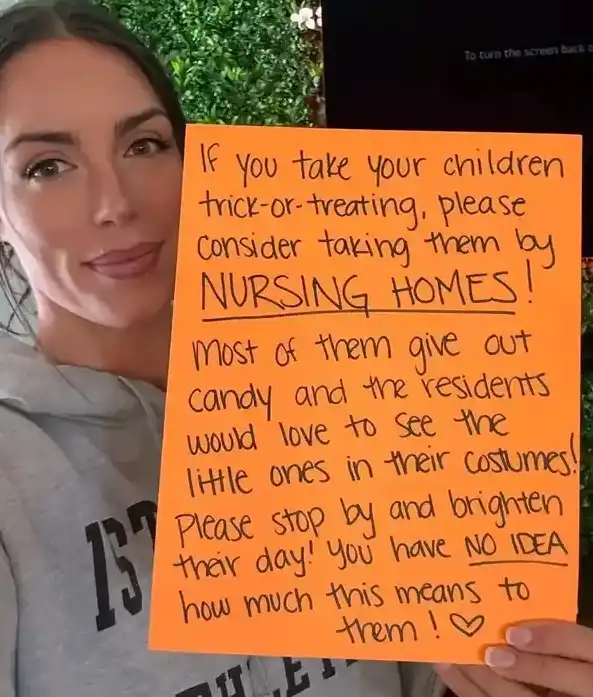3 tips for a Halloween visit to senior living homes that kids and adults both will cherish
It can be a big pick-me-up for seniors, but there are some guidelines to make it a positive experience for all.
A kid trick or treats in a ghost costume. An elderly man is flustered.
What's better than combining eager Halloween-celebrating kids with the elderly who could use some visitors? Why trick-or-treating of course! This idea has been making the rounds and many are sharing their cute TikTok videos to prove the joy.
Just this week, Upworthy shared the heartwarming story about a mom who took her daughter (dressed head to toe in princess pink) to a senior care facility, delighting many of the residents. She pranced around with her pumpkin Halloween bucket, into which senior citizens joyfully dropped candy. It inspired many to take part in this wonderful win/win for the elderly and the youth.
@karen.channnnn If you haven't gone trick or treating at a nursing or retirement home you're missing out! This is your sign! #retirement #elderly #Love #oldpeople #halloween
That said, after the idea also went viral on the subreddit r/MakeMeSmile, some people had concerns. A Redditor, @FinnFarrow, wrote "Such a good idea" and shared a picture of a woman holding an orange sign. It reads: "If you take your children trick-or-treating, please consider taking them by NURSING HOMES. Most of them give out candy, and the residents would love to see the little ones in their costumes. Please stop by and brighten their day! You have no idea how much this means to them!"
The comment section exploded, and not in the way one might think. The first is practical advice: "I would recommend contacting the nursing homes prior. I used to work in one, and they allowed it with restrictions."

Another adds, "Absolutely call beforehand though. I saw a similar post a couple of years ago and called every nursing home in town, and not one allowed trick-or-treating."
Some people were kinder in the comments than others. One bluntly points out that having lots of children in their facility could threaten health conditions of the elderly: "I would imagine bringing 100 nose miners into a nursing home during cold and flu season would be bad for residents."
Others noted that if such a thing were unexpected, it could be confusing for some of the residents. One gave the example of a man in assisted living who, when walking to the dining hall, saw kids dressed as aliens for Halloween. He did not handle it well. One points out, "It's also very funny seeing the kids try to explain their costumes to the old folks and for the old folks to try to comprehend what characters kids are wearing these days. I don’t even know, and I’m always online."

And then there's the logistics of candy. I called my mom, who is in a senior living home, and asked if her facility did this. Her answer was surprising: "I hope not. Where would I even get candy?"
But the idea is still a lovely one, at least for some. And if it's something that resonates, here are a few tips for making it work.
NOTE THE SENIOR FACILITY
There's a big difference between senior independent living, assisted living, and memory care. It's important to note that before attempting a visit which includes children. Senior independent would probably be the best place to start, as the residents (often) have fewer physical or memory-health issues.
CALL AHEAD
This might take some time, but call around to different facilities to make sure this is allowed. Usually, this is a planned event on their part, so while they may love the idea, it certainly takes coordination. The site, A Place for Mom can offer a list of nearby residences.
OFFER A DONATION
Getting out and getting candy (or having the funds to do so) should also be a consideration for something like this. One idea is that once you've established that a facility is hosting an event like this (and/or is open to it), consider offering money to buy the actual candy. Or one could drop the candy off.
- How old is too old to trick-or-treat? Turns out, most people agree on this topic. ›
- Yes, I still take my teen trick-or-treating, costume and all ›
- Kids are trick-or-treating at nursing homes, and the reactions are absolutely joyous ›
- Older people get real about what it's like to move into a retirement community - Upworthy ›
